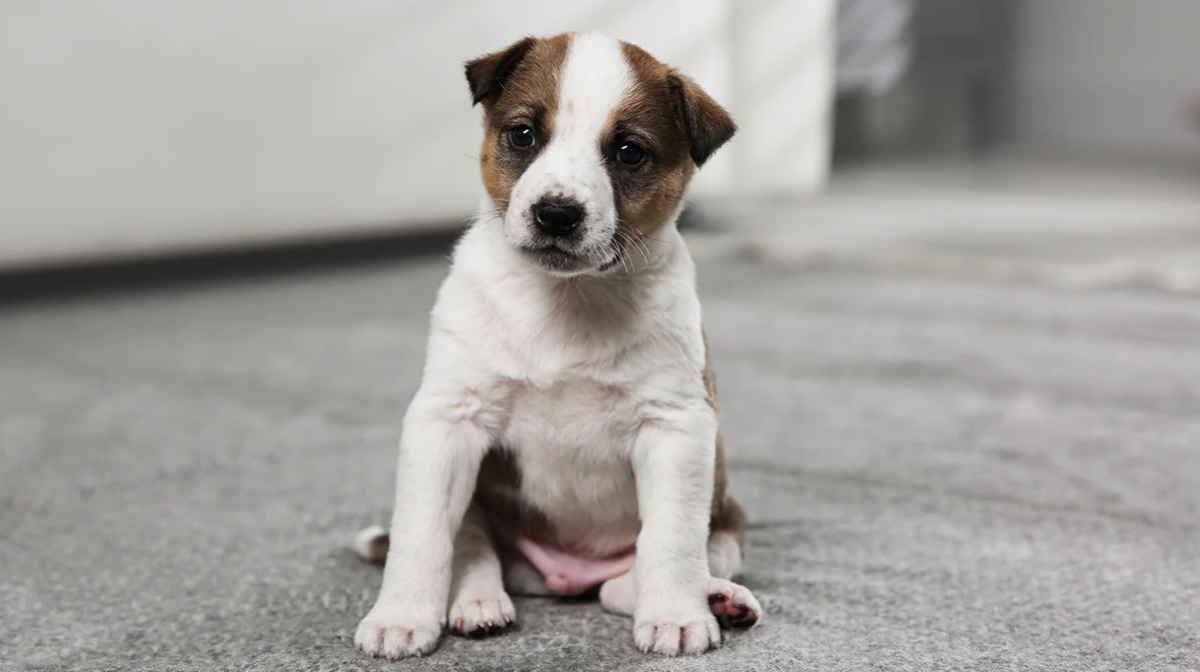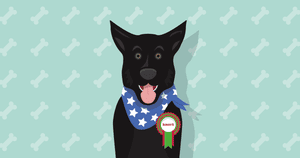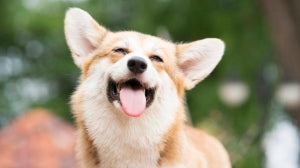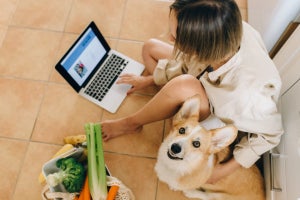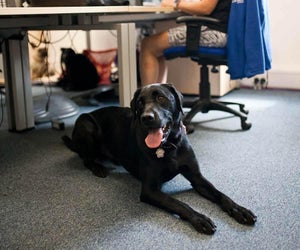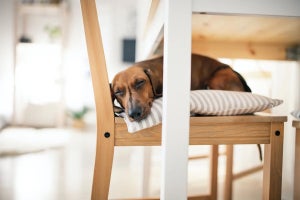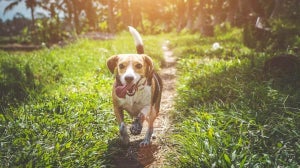
Bringing a puppy home is exhilarating and a little bit scary due to all the responsibility it brings! By now, you’ve probably researched the best dog for your family and how to puppy-proof your home. You’re almost all set.
Puppy potty training can take some owners by surprise, as there are lots of factors to consider, and accidents on the path to potty training can be expensive if they happen on the new carpet! Potty training can take anywhere from a few weeks to a year, so getting the right guidance is key to successfully toilet training puppies and avoiding incidents around the home. Potty training also lays down the foundations for the rest of your training together. Puppies thrive when they have a structured routine and toilet training is one of the first routines you must establish; patience and consistency are key.
Toilet Training Puppies
Puppy potty training can feel like an Olympic sport sometimes because puppies have a small bladder capacity. When should a puppy be toilet trained? At 8 weeks old, your puppy will need to wee approximately every 2 hours. This means that someone will need to be ready to take your puppy outside very regularly, even at early times of the morning when you’d rather have a lie-in. There are key moments when you should keep an eye on them, such as after eating or sleeping, as it’s more likely they will need to go to the toilet at these times. Adapting your potty training to the age and learning pace of your puppy is recommended.
Remember, don’t panic if it all feels a bit intense! As your puppy gets older, the frequency of urination will go down, and they will even be able to sleep all night through.
How to Toilet Train Your Puppy
Dogs and puppies are creatures of habit and thrive with structured routines. It’s best to keep some consistency during puppy potty training. Make sure you’re taking your puppy out regularly; it’s also important to take them to the same spot every time. Feeding times should be consistent; this also keeps your puppy’s toilet habits regular! You should always aim to take them out after meals, too. These things take time, and you must remember not to punish or scold your puppy for making mistakes; this could jeopardise your progress in the long run and make your pet fearful of you.
When toilet training puppies, you should encourage your puppy by rewarding them with treats when they follow the correct toilet routine. It helps them understand when and where they’re doing the right thing. Whether it be sitting, laying down, or, in this case, toilet training, make sure you praise your pup when they get it right.
Your puppy will start to learn your chosen potty routine faster if you keep it as consistent as possible. For example, be sure to choose which door you use to let your puppy outside and stick to it. This way, they will understand that every two hours you are going to take them outside and they will know where to go.
Puppy Potty Training Tips
How and when do I toilet-train my puppy? We’ve put together our best puppy potty training tips so you can be prepared for everything.
Positive Reinforcement
When reading up on puppy training, a phrase you’ll often hear is ‘positive reinforcement’. This is a technique used to help puppies and dogs understand when and where they’re doing the right thing. Make sure you praise your pup verbally when they get it right and use their favourite treats to reward them for doing a great job too.
Do Not Punish Them for Accidents
Responding negatively when training your puppy is frustrating and stressful for them. Letting your puppy know you are very happy when they follow the correct toilet routines is pivotal to a puppy’s success during your training sessions. Ensure every family member is also congratulating the puppy when they go to the toilet outside as this can also encourage them. Focus on positive reinforcement rather than scolding them. Make sure to puppy-proof the home.
Knowing the Signs
Puppies will usually try to let you know that they need to go to the toilet, and there are various physical cues to look out for. Watch out for barking, scratching at the door, circling the room, squatting, restlessness and sniffing. If they start circling the same area more than twice, take them outside straight away; they’re about to go!
While puppies are in a crate, they will mimic this same behaviour. Once they’ve decided they don’t want to go inside their sleeping area, they will often cry to let the house know they need the toilet. So, make sure you look and listen for the signs they’re giving you.
Using the Word “Toilet”
Another important part of successful toilet training is word association. For example, saying the word “toilet” while preparing to let your puppy out, while they are sniffing the ground, while they are going to the toilet, and when the puppy is finished can help. Your puppy will begin to associate the word “toilet” with going outside. Eventually, you can say the word, and the dog will learn to wait while you’re getting ready to let them out.
Once again, this is where positive reinforcement is key. After your puppy has finished, it’s important to praise them. A “good boy!” or a “well done, girl!”, may seem silly to some, but when you’re excited, your dog is excited too. This level of constant positive reinforcement is an excellent way to ensure your puppy is toilet trained quickly and effectively.
Very good training could result in a toilet-trained puppy in less than two weeks. Of course, puppies will always have accidents, but you can minimise these with the appropriate steps. If your puppy isn’t trained at this time, don’t fret. Stay calm and be patient. Some puppies learn quicker than others. Above all, remember to remain consistent and stay positive!
Choosing The Right Place
Puppies prefer a clean, quiet area to poop which has a familiar smell; they may also prefer certain surfaces over others, e.g., grass. Understanding and anticipating your puppy’s bathroom preferences will help you teach potty training faster. As mentioned before, always praise your puppy when they use the correct potty location too.
Using a Crate
If you want to speed the training process up and make it more effective, crate training can be a good solution. Puppies will not usually go to the toilet where they sleep, so they will try and let you know that they need the toilet rather than going inside the crate.
When choosing your crate, you want to find one small enough so your puppy doesn’t have enough room to wee in the corner of the crate without being affected while they sleep, but big enough that they’re not confined or uncomfortable. A crate that your puppy can sit up in and turn around is a good guide. Depending on the breed, you can expect to buy at least two or three crates in their lifetime.
Toilet Training When Your Puppy Is by Themselves
Until your dog is old enough that they can hold their urine for longer, you may also need to utilise training pads to allow your dog to relieve themselves inside. A training pad can be newspapers, wee pads, a litter box or even a turf box.
Puppy pads are a great option for your pet to use while you are at work to avoid accidents. You will need to choose a spot to place the training pad and let your puppy know that you want them to wee on the pad. It won’t take long for them to understand. You will have accidents at the beginning, but make sure you praise your pet when they do it right. The kitchen floor can be a good location for the training pad, as it’s easier to clean in case there are any surprises!
What is the fastest way to potty train a puppy?
Looking for advanced puppy potty training tips to provide quick fixes? Unfortunately, there are no quick fixes for toilet training puppies and it takes dedication and patience. However, establishing a strong bathroom routine early with your puppy or dog is key to a healthy, happy pet and a clean home. Research how often your dog or puppy should need to go to the toilet and work with their schedule. Keep feeding times regular and always be aware of the signs that your puppy is trying to tell you that they need to go! Use praise and treats to encourage them to follow the routine, and pick a location and stick to it; this will also discourage them from having accidents around the home. Don’t forget to stock up on all the essentials beforehand, such as treats and puppy pads.
How long should it take for a puppy to be toilet trained?
It can take anywhere from a few weeks to a year to toilet train your puppy; however, on average, it usually takes 4-6 months. This is why toilet training is one of the most important routines you can establish with your new pet. Punishing your pet for accidents can hinder the process, and the same can be said for an inconsistent potty routine. Patience and consistency are key.
At what age should a puppy be toilet trained?
When should a puppy be toilet trained? Puppies generally start potty training between 8 and 16 weeks old; however, it could take up to a year for some dogs to be fully house trained. The time it takes depends on several factors, including their size, breed and previous living conditions. We like to say the earlier, the better. Use our puppy potty training tips to guide you along the way, and good luck!
Looking for more advice about how to ensure a safe and regulated breeding environment for all types of dogs and pets? Join our free James Wellbeloved™ Puppy Club for expert advice!

Related Articles

